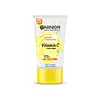What's inside
What's inside
 Key Ingredients
Key Ingredients

 Benefits
Benefits

 Concerns
Concerns

 Ingredients Side-by-side
Ingredients Side-by-side

Water
Skin ConditioningSodium Laureth Sulfate
CleansingCocamidopropyl Betaine
CleansingSodium Chloride
MaskingAmmonium Lauryl Sulfate
CleansingHippophae Rhamnoides Fruit Extract
Skin ConditioningSodium Benzoate
MaskingLaureth-3
EmulsifyingSodium Sulfate
Citrus Limon Fruit Extract
MaskingOryza Sativa Bran Extract
Skin ConditioningGinkgo Biloba Leaf Extract
Skin ConditioningButylene Glycol
HumectantThuja Orientalis Leaf Extract
AntioxidantDisodium EDTA
Lavandula Angustifolia Extract
Skin ConditioningRosmarinus Officinalis Extract
AntimicrobialThymus Vulgaris Extract
PerfumingOriganum Vulgare Flower/Leaf/Stem Extract
Skin ConditioningZanthoxylum Piperitum Fruit Extract
Skin ConditioningChrysanthemum Morifolium Flower Extract
Skin ConditioningJasminum Sambac Flower Extract
MaskingSpiraea Ulmaria Flower Extract
Skin ConditioningPrunus Mume Flower Extract
Skin ConditioningRobinia Pseudoacacia Flower Extract
Skin ConditioningSambucus Nigra Flower Extract
RefreshingNelumbo Nucifera Flower Extract
Skin ConditioningHyacinthus Orientalis Extract
Skin ConditioningPolygonum Cuspidatum Root Extract
Antioxidant1,2-Hexanediol
Skin ConditioningCentella Asiatica Extract
CleansingPolygala Tenuifolia Root Extract
Skin ConditioningPlatycodon Grandiflorus Root Extract
AntioxidantPentasodium Tetracarboxymethyl Acetylhydroxyprolyl Dipeptide-12
Skin ConditioningPentasodium Tetracarboxymethyl Dipeptide-51
Skin ConditioningEthylhexylglycerin
Skin ConditioningCaprylyl Glycol
EmollientAscorbyl Glucoside
AntioxidantSodium Ascorbyl Phosphate
AntioxidantMagnesium Ascorbyl Phosphate
AntioxidantTetrahexyldecyl Ascorbate
AntioxidantSodium Riboflavin Phosphate
Skin ConditioningParfum
MaskingWater, Sodium Laureth Sulfate, Cocamidopropyl Betaine, Sodium Chloride, Ammonium Lauryl Sulfate, Hippophae Rhamnoides Fruit Extract, Sodium Benzoate, Laureth-3, Sodium Sulfate, Citrus Limon Fruit Extract, Oryza Sativa Bran Extract, Ginkgo Biloba Leaf Extract, Butylene Glycol, Thuja Orientalis Leaf Extract, Disodium EDTA, Lavandula Angustifolia Extract, Rosmarinus Officinalis Extract, Thymus Vulgaris Extract, Origanum Vulgare Flower/Leaf/Stem Extract, Zanthoxylum Piperitum Fruit Extract, Chrysanthemum Morifolium Flower Extract, Jasminum Sambac Flower Extract, Spiraea Ulmaria Flower Extract, Prunus Mume Flower Extract, Robinia Pseudoacacia Flower Extract, Sambucus Nigra Flower Extract, Nelumbo Nucifera Flower Extract, Hyacinthus Orientalis Extract, Polygonum Cuspidatum Root Extract, 1,2-Hexanediol, Centella Asiatica Extract, Polygala Tenuifolia Root Extract, Platycodon Grandiflorus Root Extract, Pentasodium Tetracarboxymethyl Acetylhydroxyprolyl Dipeptide-12, Pentasodium Tetracarboxymethyl Dipeptide-51, Ethylhexylglycerin, Caprylyl Glycol, Ascorbyl Glucoside, Sodium Ascorbyl Phosphate, Magnesium Ascorbyl Phosphate, Tetrahexyldecyl Ascorbate, Sodium Riboflavin Phosphate, Parfum
Water
Skin ConditioningGlycerin
HumectantMyristic Acid
CleansingPalmitic Acid
EmollientStearic Acid
CleansingPotassium Hydroxide
BufferingLauric Acid
CleansingGlyceryl Distearate
EmollientGlyceryl Stearate
EmollientKaolin
AbrasivePEG-14m
Emulsion StabilisingLinalool
PerfumingParfum
MaskingSalicylic Acid
MaskingPhenoxyethanol
PreservativeLimonene
PerfumingTetrasodium EDTA
Citrus Limon Fruit Extract
MaskingCitrus Junos Fruit Extract
Skin ConditioningButylene Glycol
HumectantBenzyl Salicylate
PerfumingBenzyl Alcohol
PerfumingWater, Glycerin, Myristic Acid, Palmitic Acid, Stearic Acid, Potassium Hydroxide, Lauric Acid, Glyceryl Distearate, Glyceryl Stearate, Kaolin, PEG-14m, Linalool, Parfum, Salicylic Acid, Phenoxyethanol, Limonene, Tetrasodium EDTA, Citrus Limon Fruit Extract, Citrus Junos Fruit Extract, Butylene Glycol, Benzyl Salicylate, Benzyl Alcohol
 Reviews
Reviews

Alternatives
Ingredients Explained
These ingredients are found in both products.
Ingredients higher up in an ingredient list are typically present in a larger amount.
Butylene Glycol (or BG) is used within cosmetic products for a few different reasons:
Overall, Butylene Glycol is a safe and well-rounded ingredient that works well with other ingredients.
Though this ingredient works well with most skin types, some people with sensitive skin may experience a reaction such as allergic rashes, closed comedones, or itchiness.
Learn more about Butylene GlycolCitrus Limon Fruit Extract comes from lemons. While lemon extract is exfoliating and antimicrobial, it can also cause skin sensitivity.
Lemons contains antioxidants, which may help with anti-aging. They are also rich in citric acid, an AHA.
And of course, lemons are rich in Vitamin C. Vitamin C helps with skin-brightening and increasing collagen production.
The acidity of lemons may work as an astringent for acne.
However, lemons can also cause skin sensitivity due to its limonene content. It can also increase photosensitivity, or sensitivity to the sun.
This ingredient is also used to add a lemon scent to products.
Learn more about Citrus Limon Fruit ExtractParfum is a catch-all term for an ingredient or more that is used to give a scent to products.
Also called "fragrance", this ingredient can be a blend of hundreds of chemicals or plant oils. This means every product with "fragrance" or "parfum" in the ingredients list is a different mixture.
For instance, Habanolide is a proprietary trade name for a specific aroma chemical. When used as a fragrance ingredient in cosmetics, most aroma chemicals fall under the broad labeling category of “FRAGRANCE” or “PARFUM” according to EU and US regulations.
The term 'parfum' or 'fragrance' is not regulated in many countries. In many cases, it is up to the brand to define this term.
For instance, many brands choose to label themselves as "fragrance-free" because they are not using synthetic fragrances. However, their products may still contain ingredients such as essential oils that are considered a fragrance by INCI standards.
One example is Calendula flower extract. Calendula is an essential oil that still imparts a scent or 'fragrance'.
Depending on the blend, the ingredients in the mixture can cause allergies and sensitivities on the skin. Some ingredients that are known EU allergens include linalool and citronellol.
Parfum can also be used to mask or cover an unpleasant scent.
The bottom line is: not all fragrances/parfum/ingredients are created equally. If you are worried about fragrances, we recommend taking a closer look at an ingredient. And of course, we always recommend speaking with a professional.
Learn more about ParfumWater. It's the most common cosmetic ingredient of all. You'll usually see it at the top of ingredient lists, meaning that it makes up the largest part of the product.
So why is it so popular? Water most often acts as a solvent - this means that it helps dissolve other ingredients into the formulation.
You'll also recognize water as that liquid we all need to stay alive. If you see this, drink a glass of water. Stay hydrated!
Learn more about Water